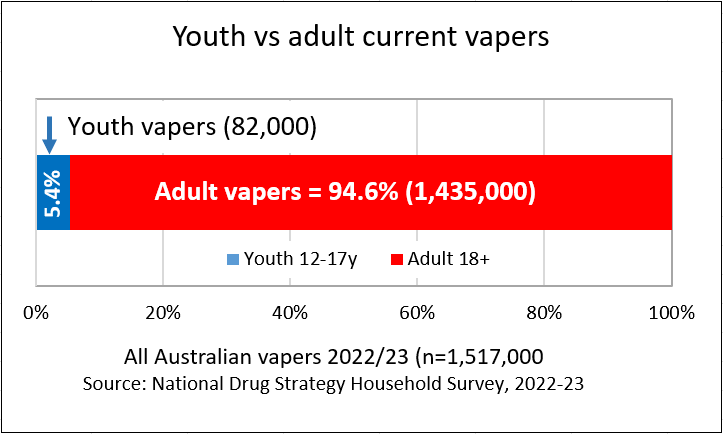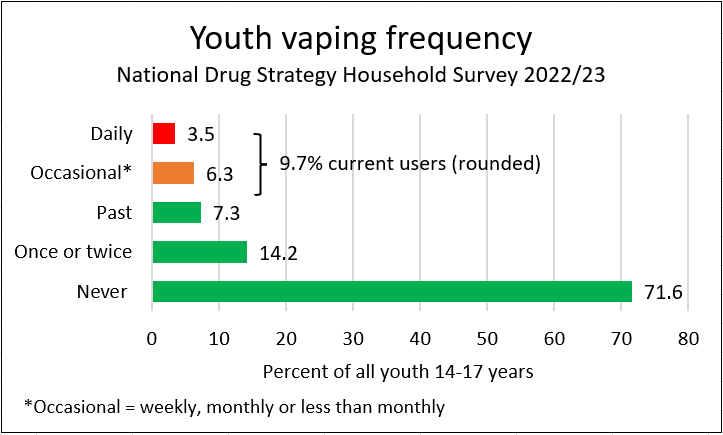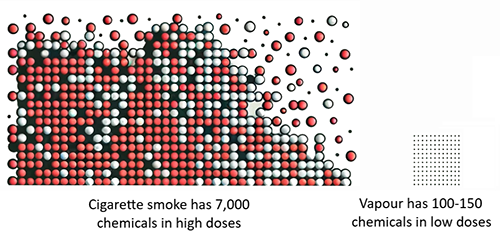
Debunking Anti-Vaping Claims in the Senate Inquiry
Posted on April 30, 2024 By Colin
THE SENATE INQUIRY INTO VAPING has been inundated with submissions from respected Australian health organisations and academics. However, a closer analysis reveals that many of these submissions are rife with misleading or exaggerated information and lack evidence-based support.
I analysed the submissions from 7 organisations and 3 academics (# 3, 8, 29, 56, 57, 59, 60, 61, 65 and 71). [link] Some of the most common and most egregious claims are described below.
The overriding flaw is that policy recommendations are driven by the trivial harms from youth vaping when youth make up only 5% of the Australian vaping population. [link] However, policy should be based on achieving the best overall impact on public health. The substantial health benefits of vaping for the adults who make up 95% of the vaping population must not be overlooked.

1. Moral panic about youth vaping
Most anti-vaping submissions emphasise the “alarming” rise in youth vaping. However, the true prevalence is far less worrying. Most vaping by young non-smokers is experimental and transient. Only 3.5% of 14-17-year-olds vape daily, and a significant portion of these are smokers or former smokers. Of all kids who try vaping, half do it only once twice (14.2%). Another 6.3% vape occasionally. [link]

Most youth vaping is experimental or occasional
The risks of youth vaping are also greatly exaggerated. Vaping only carries relatively minor health risks for young people as the dominant vaping pattern is occasional and short-term vaping. [link] There is no good evidence the common claim that vaping causes adolescent brain damage [link] or mental health disorders, except for anxiety and depression during withdrawal. [link]
Concerns about nicotine dependence are also overblown. Rather than a “new generation addicted to nicotine”, only 3-8% of 14-17-year-olds may be addicted. [link]
The widespread alarm about increased vaping by young adults 18-24 years ignores the fact that smoking rates are falling faster in this group than any other age group, as vaping diverts young people away from smoking. [link]
It should be noted that young people have easy access to vapes because the failed prescription-only model has created a thriving black market [link]
Youth vaping would be greatly reduced if vapes were regulated as adult consumer products, sold from legal, licensed retail premises with strict age verification.
2. Debunking the gateway to smoking
One of the most persistent myths surrounding vaping is its alleged role as a gateway to smoking. However, empirical evidence contradicts this assertion, with smoking rates plummeting in regions where vaping is prevalent. Rather than serving as a gateway, vaping acts as a diversion, steering young individuals away from traditional tobacco consumption—a development that should be lauded for its public health implications. [link]

Youth smoking rates are declining as vaping increases
3. A public health opportunity
Many of the submissions frame vaping as a threat to public health that will undermine progress in tobacco control. This is arrant nonsense. In fact, vaping is a huge opportunity for public health. Vaping has proven efficacy as a smoking cessation aid, driving quit attempts and reducing smoking rates at a population level. The small harms in young people pale in comparison to the benefits for adult smokers. [link]
Modelling studies that compare both the benefits of adults quitting and the harms of youth vaping consistently conclude that vaping is beneficial overall to public health and will save lives. [link]
4. Tackling the black market
Many submissions naively claim that increased policing and border control will effectively cut off the illicit supply. However, law enforcement experts say that a crackdown will have little effect on supply and use of vapes and that the black market will continue to thrive. [link]
Several submissions argue that Australia’s regulations are not a ban or prohibition. However, the harsh regulations amount to prohibition in practice as the overwhelming majority of vapers have rejected the prescription model and source supplies from the black market. [link]
5. Dispelling exaggerated risks
Misconceptions about the risks of vaping abound, often fueled by sensationalised claims and cherry-picked data. Many submissions highlight the presence of "harmful chemicals" without acknowledging that most are at very low levels, and in most cases are below the level that causes harm. [link | link]

Some submissions raise false fears about the serious lung disease EVALI and lung injury, which are not caused by nicotine vapes. [link] The risk of respiratory [link] and cardiovascular disease are exaggerated and misrepresented. There is no evidence that vaping causes seizures as many claim [link] or that it leads to mental health conditions. [link]
6. Reliance on flawed reports
Most anti-vaping submissions lean heavily on the Banks ANU [link] and NHMRC [links] reports. Critical analysis reveals the misinformation and scientific inaccuracies embedded within these reports, rendering them unfit for informing policymaking decisions. Both have been harshly critiqued in peer-reviewed articles [Banks | NHMRC].

A harsh critique of the NHMRC position statement on vaping
The World Health Organisation is also widely quoted, although its credibility on vaping has been severely challenged recently. [link]
7. Disentangling vaping from the tobacco industry
Many submissions attempt to vilify vaping by associating it with Big Tobacco. They claim that vaping is not harm reduction but is a Big Tobacco invention designed to addict children to nicotine.
This, of course, is complete nonsense. Big Tobacco did not invent vaping and only controls 26% of the global vaping market (EcigIntelligence). Vaping is an existential and disruptive threat to the lucrative cigarette monopoly and tobacco companies are transitioning to safer nicotine alternatives in order to compete. This is a good thing. None of the devices used by Australian youth are made by Big Tobacco. [link]
8. Youth vaping in other countries
Some submissions point to an increased vaping rate in Canadian and New Zealand teens since the adoption of regulation to legalise and regulate vaping.
Canada
Canadian youth vaping increased after legislation was introduced in 2018, and opponents claim that legalising and regulating vapes caused this increase. However, this explanation is highly unlikely. The increase is more plausibly be explained by the following:
- A similar sharp rise in vaping was seen in the US youth in 2018 and 2019
- Vaping was rising before the legislation and has since started to decline
- Juul arrived in Canada in 2018 and led to a substantial increase by teens
- Furthermore, youth smoking in Canada has all but disappeared

Youth vaping and smoking in Canada
New Zealand
A similar sharp increase in youth vaping in NZ mostly occurred before the 2020 legislation to legalise and regulate vaping. After the legislation was enacted, youth vaping has started to level out. Critics fail to mention that youth smoking in NZ has almost disappeared (daily smoking was 1% in 2023). Furthermore, the adult smoking rate has declined by 14% per year since 2020, compared to 9.5% per year in Australia. [link]
9. Addressing the environmental impact

Currently most vapes are sold illegally on social media and at retail outlets. Recycling is not an option for these illegal sales.
An industry-funded recycling plan could be introduced under government stewardship if vapes are legalised as adult consumer products sold from licensed retail outlets. This would include mandatory recycling at point-of-sale, incentives for consumers, public education and collection by approved recycling companies. [link]
Conclusion
Many anti-vaping submissions to the Senate Inquiry confuse correlation with causation, exaggerate risks, cherrypick data, draw false conclusions and rely on discredited sources.
The Committee needs to carefully review the information provided and not be misled by rhetoric which does not reflect the growing evidence base. Respected health organisations and academics should be treated with skepticism until proven to be grounded in empirical data and rigorous analysis.